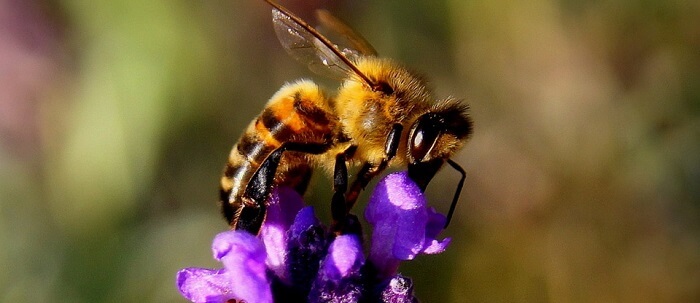Bal Arısının ingilizce tanıtımı. Bal Arısı, Honeybee nasıl bir hayvandır, yaşam koşulları, özellikleri ile ilgili ingilizce bilgi, yazı.

HONEYBEE
Honeybees live in colonies with one queen running the whole hive. Worker honeybees are all females and are the only bees most people ever see flying around outside of the hive. They forage for food, build the honeycombs, and protect the hive. Many species still occur in the wild, but honeybees are disappearing from hives due to colony collapse disorder. Scientists are not sure what is causing this collapse.
Honeybees are important pollinators for flowers, fruits, and vegetables. They live on stored honey and pollen all winter and cluster into a ball to conserve warmth. All honeybees are social and cooperative insects. Members of the hive are divided into three types. Workers forage for food (pollen and nectar from flowers), build and protect the hive, clean, and circulate air by beating their wings. The queen’s job is simple—she lays the eggs that will spawn the hive’s next generation of bees. There is usually only a single queen in a hive. If the queen dies, workers will create a new queen by feeding one of the worker females a special food called “royal jelly.” This elixir enables the worker to develop into a fertile queen.
Queens regulate the hive’s activities by producing chemicals that guide the behavior of the other bees. Male bees are called drones—the third class of honeybee. Several hundred drones live in each hive during the spring and summer, but they are expelled for the winter months when the hive goes into a lean survival mode.
Interesting Honey bee Facts:
- Honey bees live in highly organized society composed of worker bees, drones and queen. Each type of honey bee can be easily recognized because it has specific appearance, body coloration and function.
- Worker bees are the most numerous members of the hive. One hive can have up to 40 000 worker bees. They collect nectar and pollen and produce honey.
- Drones are born from unfertilized eggs. There is couple of hundreds male drones in the hive. Main function of drones is to mate with the queen.
- Hive has only one queen that is responsible for lying of eggs. Queen is able to produce 2000 eggs per day and 200 000 eggs per year.
- Each honey bee has six legs, pair of compound eyes, wings, nectar pouch and abdomen.
- Honey bee has large, hairy, compound eyes and excellent eyesight.
- Honey bees can be easily recognized even from a distance via buzzing sound that is consequence of 11 400 wing strokes in a minute.
- Each hive has specific smell which originates from pheromones (chemical signals produced by queen). This odor facilitates recognition of honey bees when they are outside the hive.
- Worker bees travel up to 6 miles at the speed of 15 miles per hour when they are searching for the pollen and nectar.
- During one trip, worker bee visits between 50 and 100 flowers.
- Honey produced in the hive is collected in the hexagonal cell made of wax. Honey bees have eight glands on the stomach which secrete substance used in the production of wax.
- One honey bee is able to produce 1/12 of the teaspoon of honey in her lifetime.
- Only worker bees and queen have stingers. Stingers are used for self-defense. Since queen never leaves the hive, she does not sting. Worker bees can sting when they are threatened. They will die immediately afterwards.
- Honey bees communicate using specific dance. Flight performed in a certain manner informs other members of the hive about good source of pollen or potential danger.
- Lifespan of honey bees depends on the type of a bee. Drones die immediately after mating. Worker bees live between 4 and 6 weeks, depending on the season and the amount of work. Queen can survive up to five years.